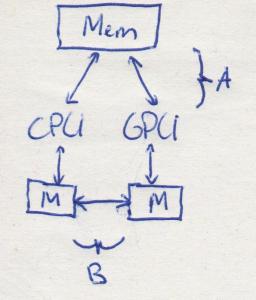
When the new supercomputer “Cartesius” of the Netherlands was presented to the public a few months ago, the buzz was not around FLOPS, but around users. SARA CEO Dr. Ir. Anwar Osseyran kept focusing on this aspect. The design of the machine was not pushed by getting into the TOP500, but by improving the performance of the current users’ software. This was applauded by various HPC experts, including StreamHPC. We need to get things done, not to win a virtual race of some number.
In the description about the supercomputer, the top500-position was only mentioned at the bottom of the page:
Cartesius entered the Top500 in November 2013 at position 184. This Top500 entry only involves the thin nodes resulting in a Linpack performance (Rmax) of 222.7 Tflop/s. Please note that Cartesius is designed to be a well balanced system instead of being a Top500 killer. This is to ensure maximum usability for the Dutch scientific community.
What would happen if you go for a TOP500 supercomputer? You might get a high energy bill and an overpriced, inefficient supercomputer. The first months you will not have full usage of the machine, and you won’t be able to easily turn off some parts, hence the spill of electricity. This results, finally, in that it is better to run unoptimized code on the cluster than to take time for coding.
The inefficiency is due to the fact that some software is data-transfer limited and other is compute-limited. No need to explain that if you go for a Top 500 and not for software optimized design, you end up buying extra hardware to get all kinds of algorithms performing. Cartesius therefore has “fat nodes” and “light nodes” to get the best bang per buck.
There is also a plan for expanding the machine over the years (on-demand growth), such that the users will remain happy instead of having an adrenaline-shot at once.
The rat-race
The HPC Top 500 is run by the company behind ISC-events. They care about their list being used, not if there is Exascale now or later. There is one company who has a particular interest in Exascale: Intel and IBM. It hardly matters anymore how it begun. What is interesting is that Intel has bought Infiniband and is collecting companies that could make them the one-stop shop for a HPC-cluster. IBM has always been strong in supercomputers with their BlueGene HPC-line. Intel has a very nice infographic on Intel+Exascale, which shows how serious they are.
But then the big question comes: did all this pushing speed up the road to Exascale? Well, no… just the normal peaks and lows round the logarithmic theoretic line:

What I find interesting in this graph is that the #500 line is diverging from the #1 line. With GPGPU is would was quite easy to enter the top 500 3 years ago.
Did the profits rise? Yes. While PC-sales went down, HPC-revenues grew:
Revenues in the high-performance computing (HPC) server space jumped 7.7 percent last year to $11.1 billion surpassing the $10.3 billion in revenues generated in 2011, according to numbers released by IDC March 21. This came despite a 6.8 percent drop in shipments, an indication of the growing average selling prices in the space, the analysts said. (eWeek.)
So, mainly the willingness of buying HPC has increased. And you cannot stay behind when the rest of the world is focusing on Exascale, can you?
Read more
- Five HPC Pitfalls – benchmarks, hardware generalisation, open software, system integration and storage aspects
- How to sell performance computing
- Green 500 – where FLOPS/Watt are important, not peak-performance.
- The 13 application areas where GPUs perform best.
- Chinese supercomputer tops the charts — two years early
Keep your feet on the ground and focus on what matters: papers and answers to hard questions.
Did you solve a compute problem and got published with an sub-top250 supercomputer? Share it in the comments!













 See the difference?
See the difference?


 Let the competition on large memory GPUs begin!
Let the competition on large memory GPUs begin!
















 The past year you might not have heard much from OpenCL-on-ARM, besides the Arndale developer-board. You have heard just a small portion of what has been going on.
The past year you might not have heard much from OpenCL-on-ARM, besides the Arndale developer-board. You have heard just a small portion of what has been going on.




 There is an interesting book coming up: “Numerical Computations with GPUs” – a book explaining various numerical algorithms with code in CUDA or OpenCL.
There is an interesting book coming up: “Numerical Computations with GPUs” – a book explaining various numerical algorithms with code in CUDA or OpenCL.
 For your convenience: an overview of all ARM-GPUs and their driver-availability. Please let me know if something is missing.
For your convenience: an overview of all ARM-GPUs and their driver-availability. Please let me know if something is missing.
 Update: we are very sorry to tell that due to a deadline in a project we were forced to cancel Vincent’s talk.
Update: we are very sorry to tell that due to a deadline in a project we were forced to cancel Vincent’s talk.


 AMD has just released an update to their AMD programming guide.
AMD has just released an update to their AMD programming guide.